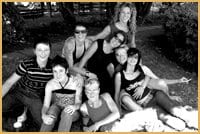
Credit: Rosamund Norbury
While the second annual Dyke March was gratefully received by all in attendance, there was none more appreciative than a 28-year-old woman from Iran, who recently went to jail for being gay in a country where being gay merits the death penalty.
When she applied for refugee status here six months ago, she met with no resistance from the Canadian government; her refugee application was accepted without so much as a hearing.
“Though in Iran many doctors accept I am a woman, but police and government don’t accept that,” says the woman (who asked that her name not be printed for her family’s safety). When her extended family used to come to visit, her parents would hide her in a room. “It makes so much trouble if they see me.”
Carolynn Dimmer, 38, is thrilled that her partner’s refugee status was approved. “Just last week, two boys, 16 and 18, were executed in Iran for being gay, first offence,” she points out.
When the authorities arrested the woman in Iran, “they tried to have sex with me,” she says. “I have bad memories of Iran and people teasing me. I am safe here; the government protects me.” She points to Dimmer: “When I kiss her and we love each other we are proud and don’t hide our love here.”
She feels grateful to the Dyke March organizers. “Thanks for collecting the women who love each other to one place and making us happy,” she smiles.
To Dimmer, the Dyke March means “feeling accepted by the community and by other people who, in Iran, would be busting our heads. We should all consider ourselves fortunate to be in Canada and able to do this.”
She, too, wants to thank the organizers for being all-inclusive and involving trans women who love each other. “It’s an opening of the community to trans women,” she smiles.
Event co-coordinator Heidi Deagle, 28, points out that among the goals of the Dyke March is making a real effort to include all women, their allies and families, including non-queer or woman-identified people.
It’s 11:30 am at McSpadden Park and co-coordinator Michelle Walker feels calm. “Like I’m in the eye of the storm,” she laughs. Walker admits to feeling anxious earlier but was pleased as women started trickling, then streaming into the park to join the growing numbers.
After an anxious and exciting week, the march is now out of their control and taking on a life of its own. They couldn’t have hoped for better weather.
Leading the march this year are nearly a dozen dykes on bikes, with the Rainbow Concert Band providing marching tunes.
The organizers moved the march’s starting point to McSpadden Park this year after receiving feedback that the first march was too short; the move added six blocks to the march.
Last year’s event attracted between 1,000 and 2,000 people.
Just back from a US book tour, local author Karen X Tulchinsky says, “We shouldn’t take for granted the rights that we have. We live in this neighbourhood and there’s tons of dykes and we should be visible.”
Waiting for the event to begin, she and her fiancée Terrie Hamazaki both want to thank the organizers for all their hard work. Tulchinsky has arranged her share of similar events and appreciates the effort involved.
The march begins and women pour out of McSpadden Park and march towards Commercial Dr.
Ellen Woodsworth, one of two queer Vancouver City councillors, is smiling and holding hands with Jo, her partner of 17 years. She’s lived in the neighborhood for 27 years.
Woodsworth thinks back to her own organizing efforts decades ago and notes the bulk of the marchers are younger women. “It’s young women coming up strong and proud. They’re a new generation coming up organized and they will infuse the gay community in a positive way. They’re going to change the world for all of us.”
Woodsworth expresses her congratulations to the organizers. She appreciates the work involved, having herself organized lesbian events in the early ’70s. She encourages women to volunteer next year and help make the event even better.
Langara College student Emer Dubois, 33, plans to take Woodsworth’s advice. “We’re celebrating the fact that we can walk in public without being bashed and bringing awareness to the fact that we’re people’s moms and sisters. I’m really glad it was organized and I will volunteer next year.”
At the Grandview Park rally after the march, Deagle makes the rounds, fundraising with a volunteer, a donation bucket and merchandise. “I’m feeling calm now. It’s a great turnout; the park feels full.”
Deagle’s partner, Walker, is standing off to one side of the rally, observing. “I’m on an adrenaline high,” she grins. “We couldn’t do this without the volunteers, the people who donate their time or the performers or those who contribute money.” She hastens to credit the board of 12 people who helped put the whole thing together.
“It’s amazing. Thanks to the people who came out,” Walker continues. “We can set the stage for this, but it takes the people coming out to make it what it is.”

 Why you can trust Xtra
Why you can trust Xtra


